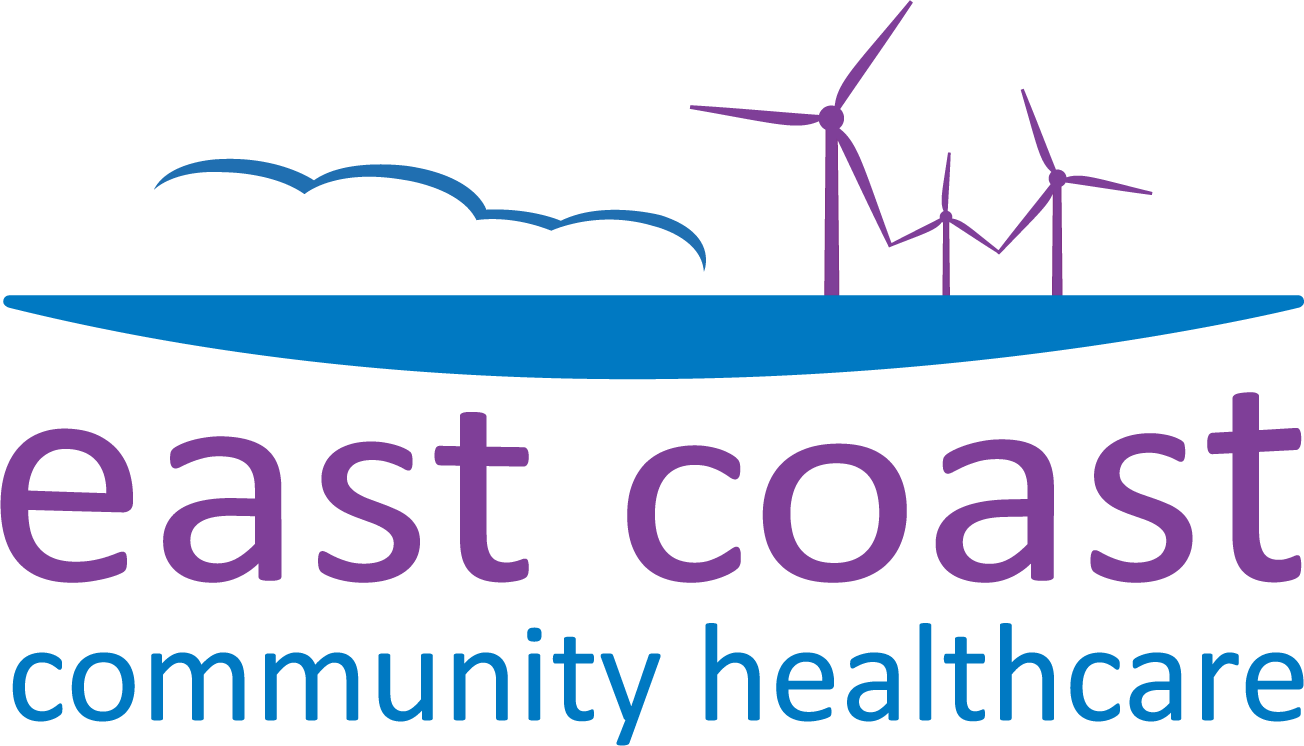Rest and Relaxation
What is Good Quality Rest?
Rest can mean different things to different people. To some people rest means sleeping or just sitting down and ‘doing nothing’. To others, rest means being able to relax.
In terms of ME/CFS, when we use the word rest it means relaxation.
Relaxation is an ideal form of good quality rest as it enables the body to be calm and re-charge. As well as providing an effective rest, relaxation helps in the management of anxiety by decreasing muscle tension and stressful thoughts.
Rest in the day is a better way to relax than sleep because people often have poor quality sleep.
What is Relaxation?
Prior to becoming ill, you may have found that things such as reading, watching television or socialising with friends a good way to relax and unwind. These things may still be relaxing. However, in the treatment of ME/CFS, a good quality rest involves letting both the mind and body relax - achieving a state of minimal brain activity. Therefore, the above are not examples of good quality rest
This is partly because individuals with ME/CFS often find they have an overactive brain or that they suffer from ‘sensory overload’, whereby they are unable to process all the information that bombards our senses.
Relaxation
Practice your relaxation at least once a day, if possible. It is only through practice that you will learn to relax as this is a skill.
Do not relax too soon after a heavy meal. Allow about an hour in between eating and relaxing.
Allow plenty of time. Practice in a quiet room (preferably not the bedroom) where you are unlikely to be disturbed. Plan to set aside a time for regular practice.
Try not to fall asleep when you are practising your relaxation unless you are using relaxation as a technique to help you get off to sleep at the end of the day. If you do this, use a specific relaxation technique that you do not use in the day.
Allow yourself to come round slowly after relaxing. Do not jump up suddenly to answer the telephone or doorbell - give yourself time.
Benefits of Relaxation
Enables the body to ‘re-charge’ and gain back some energy
Helps in the management of anxiety by decreasing muscle tension and stressful thoughts
Eases some of your aches and pains by lowering your heart rate and blood pressure for a short time
Helps to reduce the release of the stress hormones adrenaline and cortisol which can suppress immune responses and exacerbate the physical symptoms of ME/CFS
Can help to improve the sleep pattern
Promotes a calmer state - we do things more productively and use less energy when we are calm
Improves mental alertness
Rests the nervous system
It is important not to feel guilty about this way of using time. It can lead to a greater sense of well-being and allow the important events of life to be dealt with more efficiently. However, accept that it can take a while to incorporate a relaxed state into your life.
Give yourself permission to look after yourself.
Types of Relaxation Techniques
Relaxation techniques are beneficial but need practice. Most people will find that some forms of relaxation suit them more than others. It is important not to give up after the first try, as relaxation is not easy to start with.
However with practice, your ability to relax will hopefully improve and you will have gained a useful skill. Ways to relax are covered in the following pages and could include:
- Breathing exercises
- Progressive relaxation techniques
- Guided visualisation technique
- Meditation or the practice of mindfulness
- Listening to gentle music, radio, taped books
- Alternative therapies such as massage, aromatherapy and reflexology
Supportive Rest Positions
The following resting positions can be useful for when you are practising relaxation techniques as they provide maximum joint support. It would be advisable to try all of the following positions to see what you prefer. Lying positions will be more restful than sitting positions as they send less information to the brain.
Some people have found certain types of cushions and pillows helpful, as well as mattress toppers
1. Crook Lying
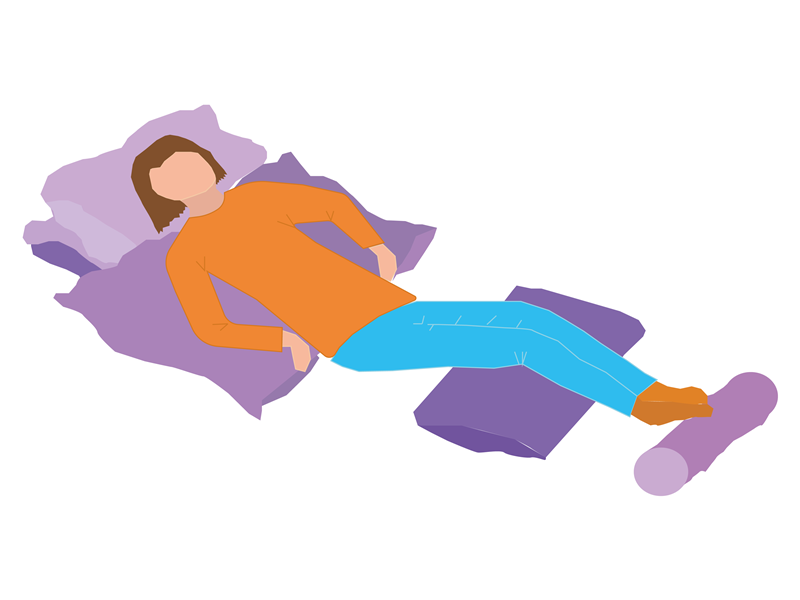
2. Side Lying
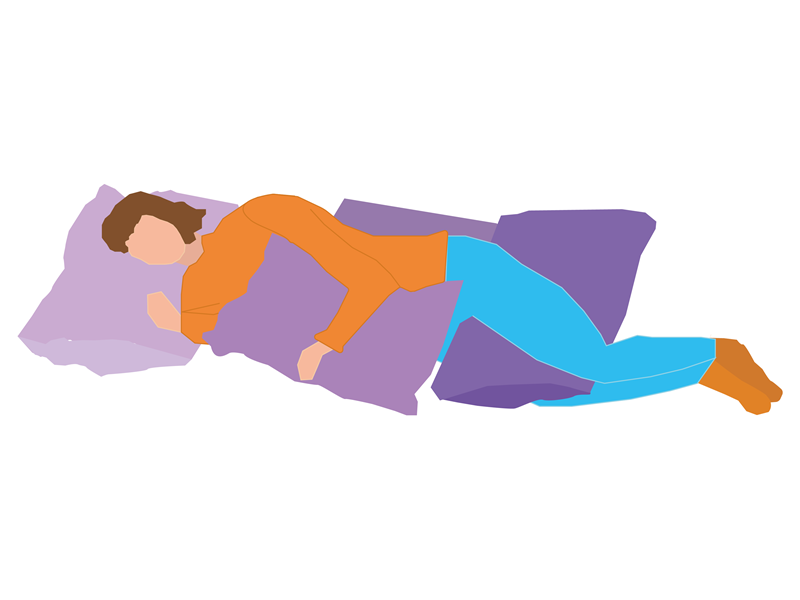
3. Long Sitting
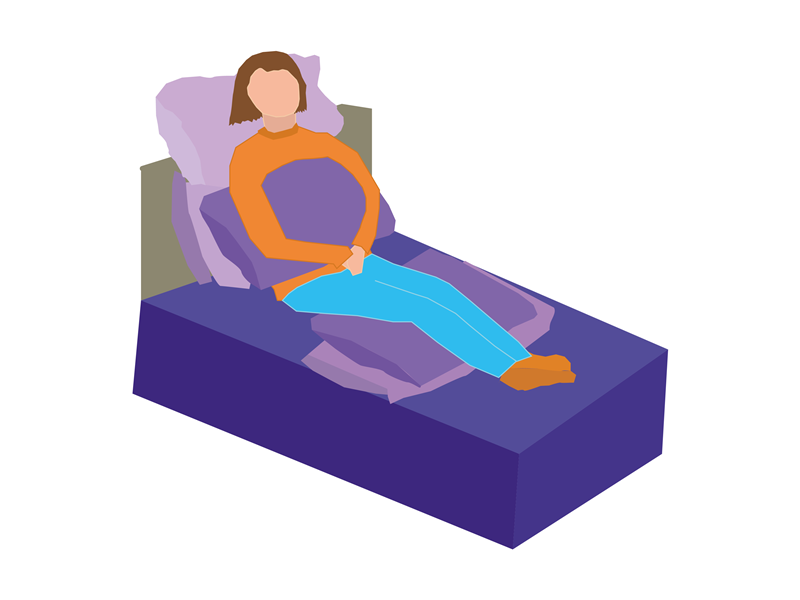
4. Chair Sitting
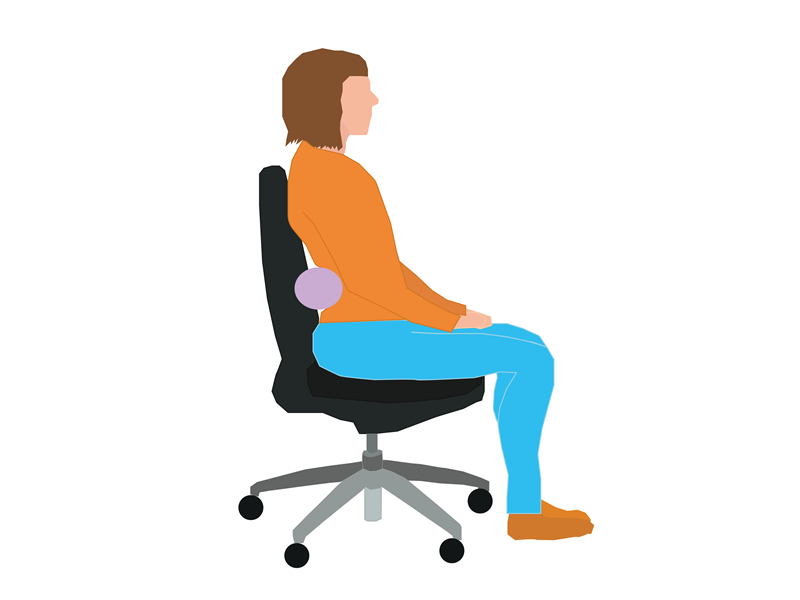
Relaxation Resources
There are many books, DVDs and CDs available from the internet, libraries, bookshops and some alternative health shops. It is advisable to experiment with different techniques, as different types of relaxation will suit different individuals. Our service has created a relaxation CD which you are welcome to borrow, or keep if you get on with it.
Specific Relaxation Techniques
On the next few pages are three different strategies and scripts for relaxation techniques. These are designed to give you a taster of formal relaxation. Generally you would not read these scripts whilst doing relaxation but ideally would listen to them on a CD, DVD or memorise them.
1) Breathing
a) Controlled Breathing - ‘Triangular Breathing’
This is a way to control the pace of your breathing.
As you breathe, imagine a triangle in your mind. Each side on the triangle lasts for four seconds. As you breathe, imagine your breath going along the triangle.
Breathe IN (1, 2, 3, 4) - Breathe OUT (1, 2, 3, 4) - Hold (1, 2, 3, 4) - (and continue)
b) Breathing from the Diaphragm
i) Breathe so that air is taken down to the abdomen i.e. your belly expands. Rest one hand on upper chest and one on navel and feel what happens when breathing in and out.
ii) Try to slow down each breath in and out to gain a slow, even rhythm and a flow from breathing in, to breathing out.
iii) Create a pattern of six to eight breaths per minute.
iv) Concentrate on taking a breath into the bottom of the lungs. As you exhale, allow your whole body to let go. Do 10 slow, full abdominal breaths without gulping in air or letting all your breath out in a rush.
v) Start doing this in a sitting position, then standing, then doing other activities.
vi) Practice for about 10 to 20 minutes, twice a day.
vii) Use this to control your breathing rate, then return to your normal rhythms.
2) Progressive muscle relaxation
Keep breathing rhythmically and slowly and deeply, relaxing a bit more with each breath... Feel the tension begin to ease away as you breathe in and out, slowly and rhythmically... Breathe in smoothly and deeply... And breathe out slowly again... Imagine yourself getting more and more heavy, sinking into your mat... Keep breathing rhythmically and, as you do, feel a sense of relief and of letting go... Try saying “relax” to yourself as you breathe in and slowly out again... Breathe like this for a few more moments...
Now, we are going to relax all the muscles of your body... Think of your feet... Let your feet go limp and floppy... Feel the tension draining away from your feet... Let your feet roll outwards and grow heavier and heavier... Imagine that they are so heavy that they are sinking into the mat... More and more relaxed... Growing heavier and more relaxed...
Now think about your calves... Imagine your leg muscles becoming floppy and heavy... Feel the tension leaving your legs, draining from your calves... Leaving your calves feeling heavy... Draining away from your feet... Leaving them feeling heavy and limp... Imagine that your legs and feet are so heavy that they are sinking into the mat... They feel limp and relaxed... Growing more and more heavy and relaxed...
Think about your thigh muscles... Now, let your legs fall apart, limply... Imagine the tension draining away from your legs... They feel limp and heavy... Your thighs feel heavy... Your calves feel heavy... Your feet feel heavy... Imagine the tension draining away... Leaving your legs... Leaving them feeling limp and relaxed... Leaving them feeling so heavy that they are sinking into the mat... Let the feelings of relaxation spread up from your feet... Up through your legs... Relaxing your hips and lower back...
Focus on the muscles of your hips and lower back...Let go of any tension...Let your muscles relax...Feel your spine supported by the mat...Feel the muscles relax...Deeper and deeper...More and more relaxed...Growing heavier and heavier...Your hips are relaxed...Your legs are relaxed...Your feet are heavy...Tension is draining away from your body...
Think of your stomach and chest muscles, and then slowly breathe out and let go of any tension... Feel your stomach muscles relax... Feel any tightness leave your chest... As you breathe evenly and calmly, your chest and stomach should gently rise and fall... Allow your breathing to become rhythmic and relaxed...
Now think about your hands and arms... Drop your arms by your side and imagine the tension draining away from your arms... Leaving your upper arms... Leaving your forearms... Draining away from your hands... Your arms feel heavy and floppy... Your arms feel limp and relaxed...
Think about the muscles in your shoulders and in your neck... Let your head sink back into the pillow... Let your shoulders drop... Let them drop even further... Feel any tension easing away from your neck and shoulders... Feel your muscles relaxing more and more deeply... Your neck is limp and your shoulders feel heavy...
Now, think about the muscles in your face... Let go of any tension... Relax your forehead and drop your jaw... Feel any strain easing... All the tension draining away from your face... Your forehead feels smooth and relaxed... Your jaw is heavy and loose... Imagine the tension leaving your face... Leaving your neck... Draining away from your shoulders... Your head, neck and shoulders feel heavy and relaxed...
Think of your whole body now... Your entire body feels heavy and relaxed... Let go of any tension... Imagine it flowing out of your body... Listen to the sound of your calm, even breathing... Your arms, legs and head feel pleasantly heavy... Too heavy to move... You may feel as if you are floating... Do not be disturbed by this, let it happen... It is part of being relaxed...
When images drift into your mind, do not fight them, just acknowledge them and let them pass... You are a bystander, interested but not involved... Enjoy the feelings of relaxation for a few more moments... If you like, picture something which gives you pleasure and a sense of calm...
Soon, I will count backwards from four to one... When I reach one, I want you to open your eyes and lie still for a few more moments, before you begin to get up... You will feel pleasantly relaxed and refreshed...
Four: Beginning to feel more alert... Three: Getting ready to start moving again... Two: Aware of your surroundings... One: Open your eyes, feeling relaxed and alert... Before you get up give a good stretch and get up slowly.
3) Guided Visualisation (10 minutes)
If using this exercise on its own, take participants through the short general relaxation instructions at the beginning.
First make yourself completely comfortable, whether you are sitting in a chair or lying on the floor. If you are wearing glasses, take them off, and loosen any tight clothing at your neck and waist. Allow your body to sink into the chair or floor. Let your legs and feet flop outwards. If you are lying on the floor, have your arms resting on the floor beside you, slightly apart from your body. If you are sitting in a chair, move your upper arms slightly away from your body, and have your hands resting comfortably on your thighs, or on the arms of the chair. Enjoy the feeling of resting, of being completely supported. Let your eyes close. Do not make any effort to keep them shut, just lower your eyelids gently over your eyes. Make sure that your lower jaw is loose, that your teeth are not clamped together, and that your tongue is not pressed against the roof of your mouth. Let your tongue lie gently in the bottom of your mouth. Have a slight gap between your upper and lower teeth, and let your lips be slightly parted.
Now become aware of your breathing. Follow the breath as it comes into and goes out of your body. Do not try to control it in any way - just observe the natural rhythm of your breathing. As you breathe out, imagine your whole body deflating, growing limp and heavy. Each time you breathe out, imagine that you are letting tension flow out of your body and mind. Focus on the word ‘calm’ as the breath flows gently in and out of your body).
Continue with this for a few minutes
Now that your body is relaxed, take yourself in your imagination to the garden of a cottage by the sea. You are sitting in a comfortable garden chair with plump cushions. All around you are the flowers of the cottage garden, and you have a wonderful view out to sea. You sit in the warmth of the sun, listening to the lazy drone of insects and the sound of gulls crying overhead. In the distance you hear the rhythmic beating of the waves on the beach below.
Relax and focus on the waves
After a while you get up from your chair, walk across the brilliant, sun-warmed grass of the lawn and go down a short flight of steps, which leads you directly on to the wide, smooth, sandy beach. You are quite alone on your stretch of sand, although you can see tiny figures playing in the distance and hear the faint sound of their voices from far away. You take off your sandals and walk over the pale, warm, dry sand down towards the water’s edge. Feel the warmth coming up from the sand beneath your feet, feel the sand between your toes. As you get nearer to the sea the sand becomes smooth and hard and damp. Feel this new texture - the sand is perfectly smooth with only a tiny pink shell glinting in the light of the sun here and there. Now you come to the water’s edge. You watch the sparkling foam running up the beach towards you and you let the warm, shallow water flow round your ankles. You look out to sea and notice a sail on the horizon - you follow it with your eyes as it moves smoothly round the headland and out of sight. Then you walk along the water’s edge, enjoying the rhythmic swish of the waves swirling round your ankles, the sunlight dancing on the water.
Enjoy this for a while
Now you turn back to go towards the house and you walk back over the smooth, hard sand and then over the dry, pale, powdery sand. You go up the steps that lead back on to the lawn and the grass feels cool and refreshing to your warm, bare, sandy feet. You sit down in your chair again, allow your eyes to close and bask in the warmth of the late afternoon sun. Sit quietly for a while and enjoy the warmth of the sun. You feel calm and relaxed, all the stresses and tension are floating away. Breathe slowly and gently, in and out, relax.
In your own time count back from five to one, and when you get to one, open your eyes, stretch, yawn, and slowly bring yourself back into the room. When you do sit up, remember to take your time. Try to hold on to the sense of relaxation that you have created for yourself.
